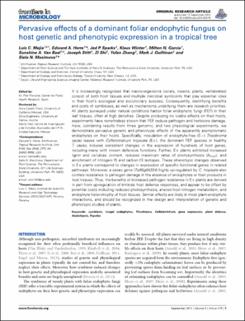| dc.contributor.author | Mejía, Luis C. | |
| dc.contributor.author | Herre, Edward A. | |
| dc.contributor.author | Sparks, Jed P. | |
| dc.contributor.author | Winter, Klaus | |
| dc.contributor.author | García, Milton N. | |
| dc.contributor.author | Van Bael, Sunshine A. | |
| dc.contributor.author | Stitt, Joseph | |
| dc.contributor.author | Shi, Zi | |
| dc.contributor.author | Zhang, Yufan | |
| dc.contributor.author | Guiltinan, Mark J. | |
| dc.contributor.author | Maximova, Siela N. | |
| dc.date.accessioned | 2020-07-02T20:27:59Z | |
| dc.date.available | 2020-07-02T20:27:59Z | |
| dc.date.issued | 2014-09-12 | |
| dc.identifier.other | https://doi.org/10.3389/fmicb.2014.00479 | |
| dc.identifier.uri | http://repositorio-indicasat.org.pa/handle/123456789/156 | |
| dc.description | It is increasingly recognized that macro-organisms (corals, insects, plants, vertebrates) consist of both host tissues and multiple microbial symbionts that play essential roles in their host’s ecological and evolutionary success. Consequently, identifying benefits and costs of symbioses, as well as mechanisms underlying them are research priorities. All plants surveyed under natural conditions harbor foliar endophytic fungi (FEF) in their leaf tissues, often at high densities. Despite producing no visible effects on their hosts, experiments have nonetheless shown that FEF reduce pathogen and herbivore damage. Here, combining results from three genomic, and two physiological experiments, we demonstrate pervasive genetic and phenotypic effects of the apparently asymptomatic endophytes on their hosts. Specifically, inoculation of endophyte-free (E−) Theobroma cacao leaves with Colletotrichum tropicale (E+), the dominant FEF species in healthy T. cacao, induces consistent changes in the expression of hundreds of host genes, including many with known defensive functions. Further, E+ plants exhibited increased lignin and cellulose content, reduced maximum rates of photosynthesis (Amax), and enrichment of nitrogen-15 and carbon-13 isotopes. These phenotypic changes observed in E+ plants correspond to changes in expression of specific functional genes in related pathways. Moreover, a cacao gene (Tc00g04254) highly up-regulated by C. tropicale also confers resistance to pathogen damage in the absence of endophytes or their products in host tissues. Thus, the benefits of increased pathogen resistance in E+ plants are derived in part from up-regulation of intrinsic host defense responses, and appear to be offset by potential costs including reduced photosynthesis, altered host nitrogen metabolism, and endophyte heterotrophy of host tissues. Similar effects are likely in most plant-endophyte interactions, and should be recognized in the design and interpretation of genetic and phenotypic studies of plants | en_US |
| dc.description.abstract | It is increasingly recognized that macro-organisms (corals, insects, plants, vertebrates) consist of both host tissues and multiple microbial symbionts that play essential roles in their host’s ecological and evolutionary success. Consequently, identifying benefits and costs of symbioses, as well as mechanisms underlying them are research priorities. All plants surveyed under natural conditions harbor foliar endophytic fungi (FEF) in their leaf tissues, often at high densities. Despite producing no visible effects on their hosts, experiments have nonetheless shown that FEF reduce pathogen and herbivore damage. Here, combining results from three genomic, and two physiological experiments, we demonstrate pervasive genetic and phenotypic effects of the apparently asymptomatic endophytes on their hosts. Specifically, inoculation of endophyte-free (E−) Theobroma cacao leaves with Colletotrichum tropicale (E+), the dominant FEF species in healthy T. cacao, induces consistent changes in the expression of hundreds of host genes, including many with known defensive functions. Further, E+ plants exhibited increased lignin and cellulose content, reduced maximum rates of photosynthesis (Amax), and enrichment of nitrogen-15 and carbon-13 isotopes. These phenotypic changes observed in E+ plants correspond to changes in expression of specific functional genes in related pathways. Moreover, a cacao gene (Tc00g04254) highly up-regulated by C. tropicale also confers resistance to pathogen damage in the absence of endophytes or their products in host tissues. Thus, the benefits of increased pathogen resistance in E+ plants are derived in part from up-regulation of intrinsic host defense responses, and appear to be offset by potential costs including reduced photosynthesis, altered host nitrogen metabolism, and endophyte heterotrophy of host tissues. Similar effects are likely in most plant-endophyte interactions, and should be recognized in the design and interpretation of genetic and phenotypic studies of plants | en_US |
| dc.format | application/pdf | |
| dc.language.iso | eng | en_US |
| dc.rights | Info:eu-repo/semantics/openAccess | |
| dc.rights | https://creativecommons.org/licenses/by/4.0/ | |
| dc.subject | symbiosis | en_US |
| dc.subject | fungal endophytes | en_US |
| dc.subject | Theobroma | en_US |
| dc.subject | Colletotrichum | en_US |
| dc.subject | gene expression | en_US |
| dc.subject | plant defense | en_US |
| dc.subject | Arabidopsis | en_US |
| dc.subject | Populus | en_US |
| dc.title | Pervasive effects of a dominant foliar endophytic fungus on host genetic and phenotypic expression in a tropical tree | en_US |
| dc.type | info:eu-repo/semantics/article | en_US |
| dc.type | Info:eu-repo/semantics/publishedversion | |

